5.4 Different Types of Communication and Communication Channels
Learning Objectives
- Describe the features and advantages of verbal communication.
- Recognize the features and advantages of written communication.
- Evaluate the features of nonverbal communication and how it interacts with verbal and written communications.
- Examine how communication channels affect communication.
- Determine different communication directions within organizations.
Communication can be categorized into three basic types: (1) verbal communication, in which you listen to a person to understand their meaning; (2) written communication, in which you read their meaning; and (3) nonverbal communication, in which you observe a person and infer meaning. Each has its own advantages, disadvantages, and even pitfalls.
Verbal Communication
Verbal communication in business takes place via phone, web based calls or conferences, media, or in person. The medium of the Message is oral. Let’s return to our printer cartridge example. This time, the Message is being conveyed from the Sender (the Manager) to the Receiver (an employee named Bill) by telephone. We’ve already seen how the Manager’s request to Bill (“We need to buy more printer toner cartridges”) can go awry. Now let’s look at how the same Message can travel successfully from Sender to Receiver.
Manager (speaking on the phone): “Good morning, Bill!”
(By using the employee’s name, the manager is establishing a clear, personal link to the Receiver.)
Manager: “Your division’s numbers are looking great.”
(The Manager’s recognition of Bill’s role in a winning team further personalizes and emotionalizes the conversation.)
Manager: “Our next step is to order more printer toner cartridges. Could you place an order for 1,000 printer toner cartridges with Jones Computer Supplies? Our budget for this purchase is $30,000, and the cartridges need to be here by Wednesday afternoon.”
(The Manager breaks down the task into several steps. Each step consists of a specific task, time frame, quantity, or goal.)
Bill: “Sure thing! I’ll call Jones Computer Supplies and order 1,000 more printer toner cartridges, not exceeding a total of $30,000, to be here by Wednesday afternoon.”
(Bill, who is good at active listening, repeats what he has heard. This is the Feedback portion of the communication, and verbal communication has the advantage of offering opportunities for immediate feedback. Feedback helps Bill to recognize any confusion he may have had hearing the manager’s Message. Feedback also helps the manager to tell whether she has communicated the Message correctly.)
Storytelling
Storytelling has been shown to be an effective form of verbal communication; it serves an important organizational function by helping to construct common meanings for individuals within the organization. Stories can help clarify key values and help demonstrate how things are done within an organization, and story frequency, strength, and tone are related to higher organizational commitment (McCarthy, 2008). The quality of the stories entrepreneurs tell is related to their ability to secure capital for their firms (Martens et al., 2007). Stories can serve to reinforce and perpetuate an organization’s culture.
Crucial Conversations
While the process may be the same, high-stakes communications require more planning, reflection, and skill than normal day-to-day interactions at work. Examples of high-stakes communication events include asking for a raise or presenting a business plan to a venture capitalist. In addition to these events, there are also many times in our professional lives when we have crucial conversations—discussions where not only the stakes are high but also where opinions vary and emotions run strong (Patterson et al., 2002). One of the most consistent recommendations from communications experts is to work toward using “and” instead of “but” as you communicate under these circumstances. In addition, be aware of your communication style and practice flexibility; it is under stressful situations that communication styles can become the most rigid.
Written Communication

In contrast to verbal communications, written business communications are printed messages. Examples of written communications include memos, proposals, e-mails, texts, letters, training manuals, and operating policies. They may be printed on paper, handwritten, or appear on the screen. Normally, a verbal communication takes place in real time. Written communication, by contrast, may be constructed over a longer period of time. Written communication is often asynchronous (occurring at different times). That is, the Sender can write a Message that the Receiver can read at any time, unlike a conversation that is carried on in real time. A written communication can also be read by many people (such as all employees in a department or all customers). It’s a “one-to-many” communication, as opposed to a one-to-one verbal conversation. There are exceptions, of course: a voicemail is an oral Message that is asynchronous. Conference calls and speeches are oral one-to-many communications, and e-mails may have only one recipient or many.
Most jobs involve some degree of writing. According to the National Commission on Writing, 67% of salaried employees in large American companies and professional state employees have some writing responsibility. Half of responding companies reported that they take writing into consideration when hiring professional employees, and 91% always take writing into account when hiring (for any position, not just professional-level ones) (Flink, 2007).
Luckily, it is possible to learn to write clearly. Here are some tips on writing well. Thomas Jefferson summed up the rules of writing well with this idea “Don’t use two words when one will do.” One of the oldest myths in business is that writing more will make us sound more important; in fact, the opposite is true. Leaders who can communicate simply and clearly project a stronger image than those who write a lot but say nothing.
Nonverbal Communication
What you say is a vital part of any communication. But what you don’t say can be even more important. Research also shows that 55% of in-person communication comes from nonverbal cues like facial expressions, body stance, and tone of voice. According to one study, only 7% of a Receiver’s comprehension of a Message is based on the Sender’s actual words; 38% is based on paralanguage (the tone, pace, and volume of speech), and 55% is based on nonverbal cues (body language) (Mehrabian, 1981).
Research shows that nonverbal cues can also affect whether you get a job offer. Judges examining videotapes of actual applicants were able to assess the social skills of job candidates with the sound turned off. They watched the rate of gesturing, time spent talking, and formality of dress to determine which candidates would be the most successful socially on the job (Gifford et al., 1985). For this reason, it is important to consider how we appear in business as well as what we say. The muscles of our faces convey our emotions. We can send a silent message without saying a word. A change in facial expression can change our emotional state. Before an interview, for example, if we focus on feeling confident, our face will convey that confidence to an interviewer. Adopting a smile (even if we’re feeling stressed) can reduce the body’s stress levels – during telephone interviews we know that interviewers can tell pick up on that smile! Smile — And The World Can Hear You, Even If You Hide
To be effective communicators, we need to align our body language, appearance, and tone with the words we’re trying to convey. Research shows that when individuals are lying, they are more likely to blink more frequently, shift their weight, and shrug (Siegman, 1985).
Watch this video: Your Body Language May Shape Who You Are by Amy Cuddy [20:46] (Transcript Available).
Another element of nonverbal communication is tone. A different tone can change the perceived meaning of a message demonstrates how clearly this can be true, whether in verbal or written communication. If we simply read these words without the added emphasis, we would be left to wonder, but the emphasis shows us how the tone conveys a great deal of information. Now you can see how changing one’s tone of voice or writing can incite or defuse a misunderstanding.
Table 5.4.1 Don’t Use That Tone with Me! (Kiely, 1993)
| Placement of the emphasis | What it means |
|---|---|
| I did not tell John you were late. | Someone else told John you were late. |
| I did not tell John you were late. | This did not happen. |
| I did not tell John you were late. | I may have implied it. |
| I did not tell John you were late. | But maybe I told Sharon and José. |
| I did not tell John you were late. | I was talking about someone else. |
| I did not tell John you were late. | I told him you still are late. |
| I did not tell John you were late. | I told him you were attending another meeting. |
Changing your tone can dramatically change your meaning.
For an example of the importance of nonverbal communication, imagine that you’re a customer interested in opening a new bank account. At one bank, the bank officer is dressed neatly. She looks you in the eye when she speaks. Her tone is friendly. Her words are easy to understand, yet she sounds professional. “Thank you for considering Bank of the East Coast. We appreciate this opportunity and would love to explore ways that we can work together to help your business grow,” she says with a friendly smile.
At the second bank, the bank officer’s tie is stained. He looks over your head and down at his desk as he speaks. He shifts in his seat and fidgets with his hands. His words say, “Thank you for considering Bank of the West Coast. We appreciate this opportunity and would love to explore ways that we can work together to help your business grow,” but he mumbles, and his voice conveys no enthusiasm or warmth.
Which bank would you choose?
The speaker’s body language must match his or her words. If a Sender’s words and body language don’t match—if a Sender smiles while telling a sad tale, for example—the mismatch between verbal and nonverbal cues can cause a Receiver to actively dislike the Sender.
Examples of nonverbal cues that can support or detract from a Sender’s Message.
- Body Language – A simple rule of thumb is that simplicity, directness, and warmth convey sincerity. And sincerity is key to effective communication. A firm handshake, given with a warm, dry hand, is a great way to establish trust. A weak, clammy handshake conveys a lack of trustworthiness. Gnawing one’s lip conveys uncertainty. A direct smile conveys confidence.
- Eye Contact – In business, the style and duration of eye contact considered appropriate vary greatly across cultures. In the United States, looking someone in the eye (for about a second) is considered a sign of trustworthiness.
- Facial Expressions – The human face can produce thousands of different expressions. These expressions have been decoded by experts as corresponding to hundreds of different emotional states (Ekman et. al., 2008). Our faces convey basic information to the outside world. Happiness is associated with an upturned mouth and slightly closed eyes; fear with an open mouth and wide-eyed stare. Flitting (“shifty”) eyes and pursed lips convey a lack of trustworthiness. The effect of facial expressions in conversation is instantaneous. Our brains may register them as “a feeling” about someone’s character.
- Posture – The position of our body relative to a chair or another person is another powerful silent messenger that conveys interest, aloofness, professionalism—or lack thereof. Head up, back straight (but not rigid) implies an upright character. In interview situations, experts advise mirroring an interviewer’s tendency to lean in and settle back in her seat. The subtle repetition of the other person’s posture conveys that we are listening and responding.
- Touch – The meaning of a simple touch differs between individuals, genders, and cultures. In Mexico, when doing business, men may find themselves being grasped on the arm by another man. To pull away is seen as rude. In Indonesia, to touch anyone on the head or touch anything with one’s foot is considered highly offensive. In the Far East, according to business etiquette writer Nazir Daud, “it is considered impolite for a woman to shake a man’s hand (Daud, 2008).” Americans, as we have noted, place great value in a firm handshake. But handshaking as a competitive sport (“the bone-crusher”) can come off as needlessly aggressive, at home and abroad.
- Space – Anthropologist Edward T. Hall coined the term proxemics to denote the different kinds of distance that occur between people. These distances vary between cultures. Standing too far away from a colleague (such as a public speaking distance of more than seven feet) or too close to a colleague (intimate distance for embracing) can thwart an effective verbal communication in business.
This figure outlines the basic proxemics of everyday life and their meaning (Hall, 1966).
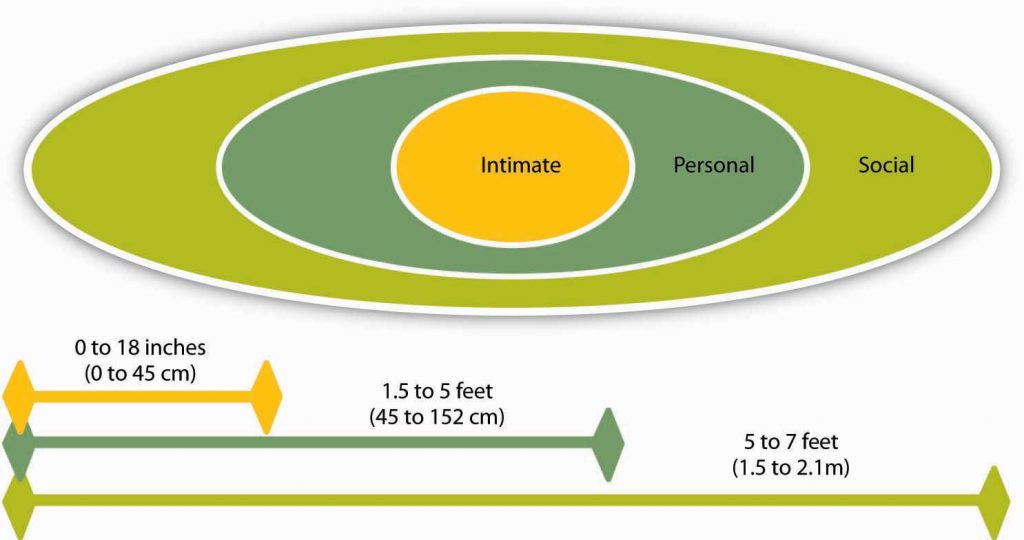
The channel, or medium, used to communicate a message affects how accurately the message will be received, so it is important to remember what the goal of your message is. Verbal, written, and nonverbal communications have different strengths and weaknesses. In business, the decision to communicate verbally or in written form can be a powerful one. In addition, a smart leader is aware of the nonverbal messages conveyed by either type of communication—as noted earlier, only 7% of verbal communication comes from the words themselves.
Information Richness
Channels vary in their information richness. Information-rich channels convey more nonverbal information. As you may be able to guess from our earlier discussion of verbal and written communications, verbal communications are richer than written ones. Research shows that effective managers tend to use more information-rich communication channels than less effective managers (Allen & Griffeth, 1997; Fulk & Boyd, 1991; Yater & Orlikowski, 1992). The figure below illustrates the information richness of different information channels.
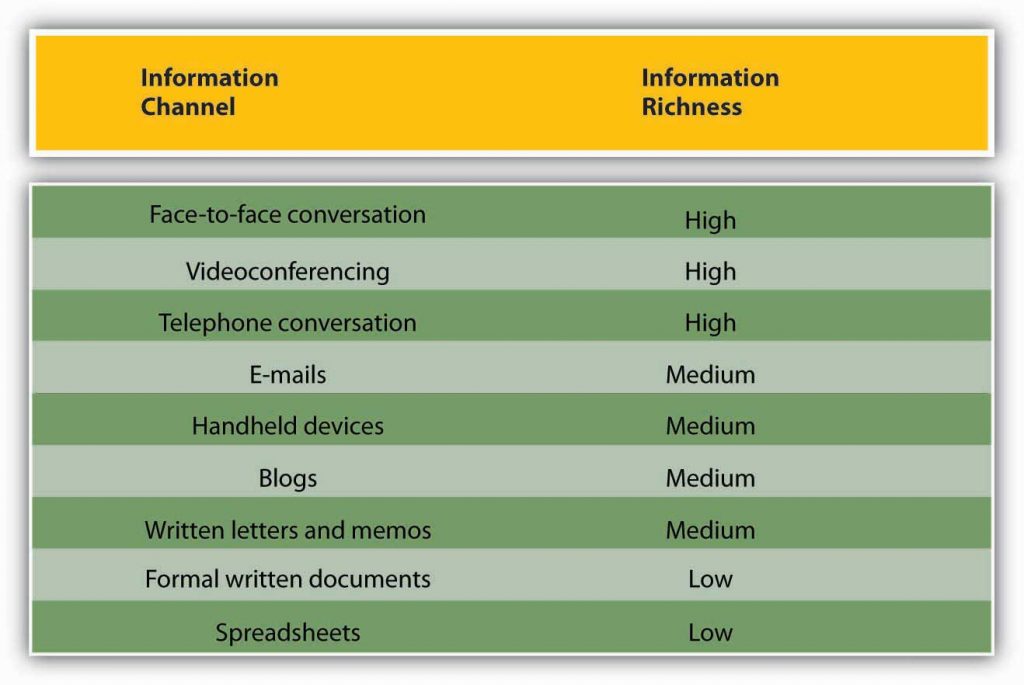
Like face-to-face and telephone conversation, videoconferencing has high information richness because Receivers and Senders can see or hear beyond just the words—they can see the Sender’s body language or hear the tone of their voice. Videoconferencing has been a huge communication asset during the pandemic as many employees have worked from home. Handheld devices, blogs, and written letters and memos offer medium-rich channels because they convey words and pictures/photos. Formal written documents, such as legal documents, and spreadsheets, such as the division’s budget, convey the least richness because the format is often rigid and standardized. As a result, nuance is lost.
In business, the decision to communicate verbally or in written form can be powerful. In addition, a smart leader is aware of the nonverbal messages conveyed by either type of communication—as noted earlier, only 7% of a verbal communication comes from the words themselves.
When determining whether to communicate verbally or in writing, ask yourself: Do I want to convey facts or feelings? Verbal communications are a better way to convey feelings. Written communications do a better job of conveying facts.
Picture a leader making a speech to a team of 20 employees. The leader is speaking at a normal pace. The employees appear interested. But how much information is being transmitted? Not as much as the speaker believes! Humans listen much faster than they speak. The average public speaker communicates at a speed of about 125 words a minute. And that pace sounds fine to the audience. (In fact, anything faster than that probably would sound weird. To put that figure in perspective, someone having an excited conversation speaks at about 150 words a minute.) On the basis of these numbers, we could assume that the employees have more than enough time to take in each word the manager delivers. And that’s the problem. The average person in the audience can hear 400–500 words a minute (Lee & Hatesohl, 2008). The audience has more than enough time to hear. As a result, they will each be processing many thoughts of their own, on totally different subjects, while the leader is speaking. As this example demonstrates, oral communication is an inherently flawed medium for conveying specific facts. Listeners’ minds wander! It’s nothing personal—in fact, it’s totally normal. In business, once we understand this fact, we can make more intelligent communication choices based on the kind of information we want to convey.
The key to effective communication is to match the communication channel with the goal of the communication (Barry & Fulmer, 2004). For example, written media may be a better choice when the Sender wants a record of the content, has less urgency for a response, is physically separated from the Receiver, doesn’t require a lot of feedback from the Receiver, or the Message is complicated and may take some time to understand. Oral communication, however, makes more sense when the Sender is conveying a sensitive or emotional Message, needs feedback immediately, and does not need a permanent record of the conversation. Use the guide provided for deciding when to use written versus verbal communication.
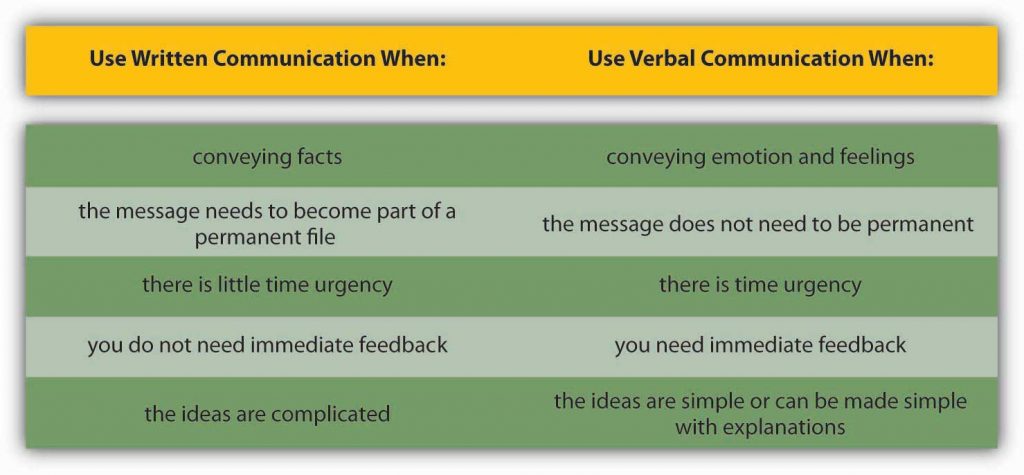
Business Use of E-Mail
The growth of e-mail has been spectacular, but it has also created challenges in managing information and an ever-increasing speed of doing business. Over 100 million adults in the United States use e-mail regularly (at least once a day) (Taylor, 2002). Internet users around the world send an estimated 60 billion e-mails every day, and many of those are spam or scam attempts (ONEINDIA, 2006). That makes e-mail the second most popular medium of communication worldwide, second only to voice. A 2005 study estimated that less than 1% of all written human communications even reached paper—and we can imagine that this percentage has gone down even further since then (Isom, 2005). To combat the overuse of e-mail, companies such as Intel have even instituted “no e-mail Fridays” where all communication is done via other communication channels. Learning to be more effective in your e-mail communications is an important skill. To learn more, check out the business e-mail do’s and don’ts.
Business E-Mail Do’s and Don’ts
- DON’T send or forward chain e-mails.
- DON’T put anything in an e-mail that you don’t want the world to see.
- DON’T write a Message in capital letters—this is the equivalent of SHOUTING.
- DON’T routinely “cc” everyone all the time, be cautious about using “reply all” unless it is necessary. Reducing inbox clutter is a great way to increase communication.
- DON’T hit Send until you spell-check your e-mail.
- DO use a subject line that summarizes your Message, adjusting it as the Message changes over time.
- DO make your request in the first line of your e-mail. (And if that’s all you need to say, stop there!)
- DO end your e-mail with a brief sign-off such as, “Thank you,” followed by your name and contact information.
- DO think of a work e-mail as a binding communication.
- DO let others know if you’ve received an e-mail in error.
(Leland et al., 2000; Kawasaki, 2006)
An important, although often ignored, rule when communicating emotional information is that e-mail’s lack of richness can be your loss. As we saw in the chart above, e-mail is a medium-rich channel. It can convey facts quickly. But when it comes to emotion, e-mail’s flaws make it far less desirable a choice than oral communication—the 55% of nonverbal cues that make a conversation comprehensible to a listener are missing. E-mail readers don’t pick up on sarcasm and other tonal aspects of writing as much as the writer believes they will, researchers note in a recent study (Kruger, 2005).
The Sender may believe she has included these emotional signifiers in her Message. But, with words alone, those signifiers are not there. This gap between the form and content of e-mail inspired the rise of emoticons—symbols that offer clues to the emotional side of the words in each Message. Generally speaking, however, emoticons are not considered professional in business communication.
You might feel uncomfortable conveying an emotionally laden message verbally, especially when the message contains unwanted news. Sending an e-mail to your staff that there will be no bonuses this year may seem easier than breaking the bad news face-to-face, but that doesn’t mean that e-mail is an effective or appropriate way to deliver this kind of news. When the Message is emotional, the Sender should use verbal communication. Indeed, a good rule of thumb is that the more emotionally laden messages require more thought in the choice of channel and how they are communicated.
Direction of Communication Within Organizations
Information can move horizontally, from a Sender to a Receiver, as we’ve seen. It can also move vertically, down from top leadership or up from the front line. Information can also move diagonally between and among levels of an organization, such as a Message from a customer service representative up to a manager in the manufacturing department, or a Message from the chief financial officer sent down to all department heads.
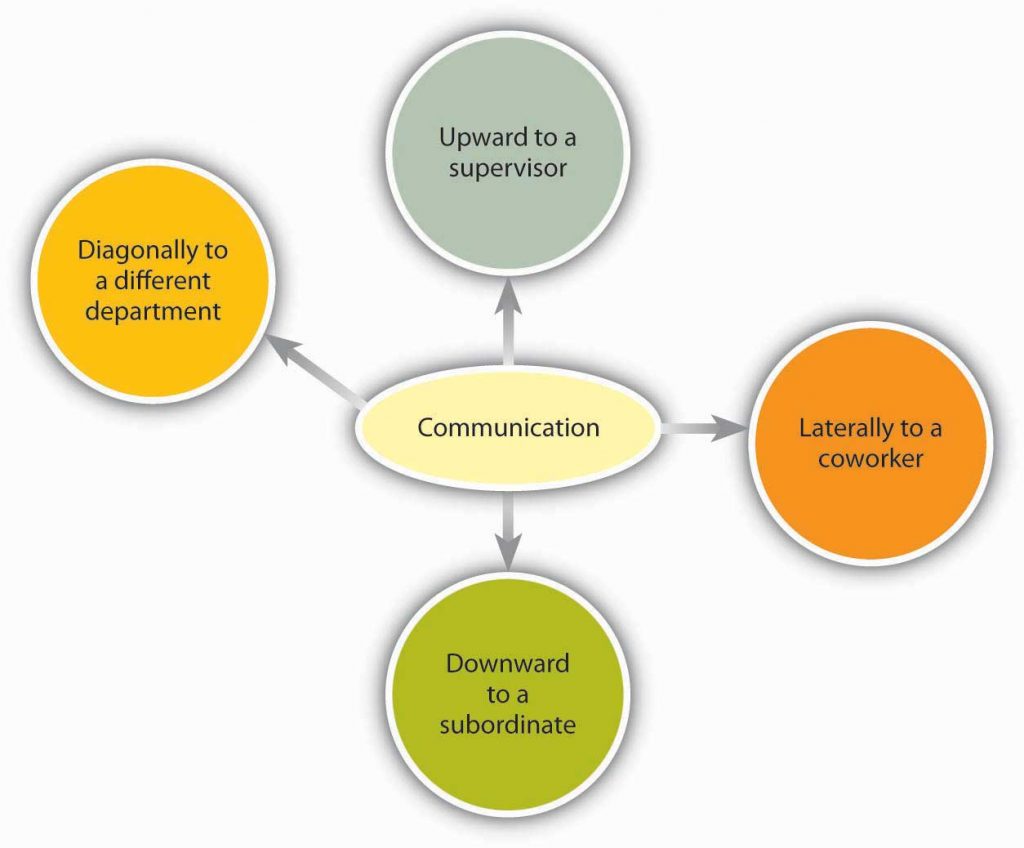
There is a chance for these arrows to go awry, of course. As Mihaly Csikszentmihalyi, author of best-selling books such as Flow, has noted, “In large organizations the dilution of information as it passes up and down the hierarchy, and horizontally across departments, can undermine the effort to focus on common goals.” Leaders need to keep this in mind when they make organization design decisions as part of the organizing function.
The organizational status of the Sender can affect the Receiver’s attentiveness to the Message. For example, consider: A senior manager sends a memo to a production supervisor. The supervisor, who has a lower status within the organization, is likely to pay close attention to the Message. The same information, conveyed in the opposite direction, however, might not get the attention it deserves. The Message would be filtered by the senior manager’s perception of priorities and urgencies.
Requests are just one kind of communication in business. Other communications, both verbal or written, may seek, give, or exchange information. Research shows that frequent communications with one’s supervisor is related to better job performance ratings and overall organizational performance (Snyder & Morris, 1984; Kacmar et al., 2003). Research also shows that lateral communication done between peers can influence important organizational outcomes such as turnover (Krackhardt & Porter, 1986).
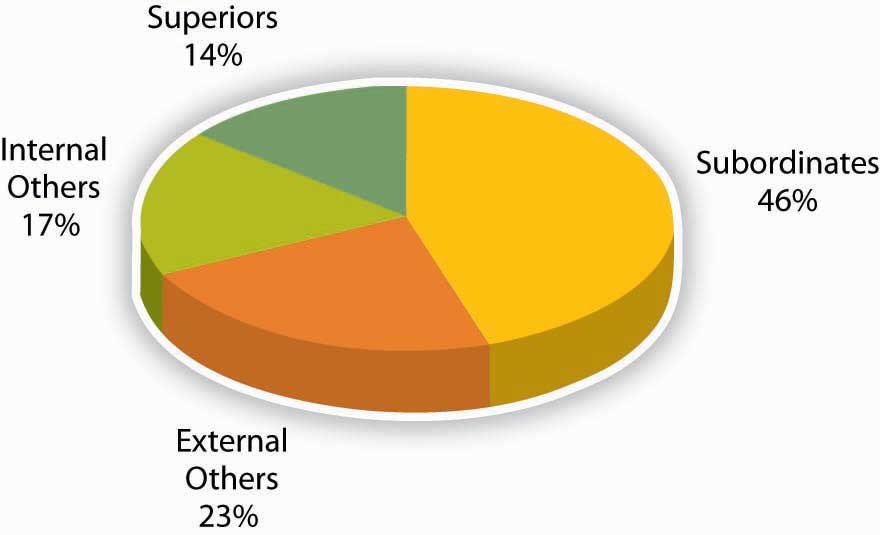
External Communications
External communications deliver specific business messages to individuals outside an organization. They may announce changes in staff or strategy, earnings, and more. The goal of an external communication is to create a specific Message that the Receiver will understand and share with others. Examples of external communications include press releases, advertisements, web pages and customer communications.
Communication is key to the creation, management, and monitoring of corporate reputation. An understanding of language and its inherent powers, combined with the skill to speak, write, listen, and form interpersonal relationships, will determine whether companies succeed or fail, and whether they are rewarded or penalized for their reputations. The decisions leaders make as to how and what to communicate strongly impact the public’s decision on whether or not to do business with an organization.
Exercises
- How could you use your knowledge of communication richness to be more effective in your own communications?
- What are the three biggest advantages and disadvantages you see regarding technology and communications?
- Explain the difference between internal and external communications in an organization, giving examples of each.
- When you see a memo or e-mail full of typos, poor grammar, or incomplete sentences, how do you react? Does it affect your perception of the Sender? Why or why not?
- How aware of your own body language are you? Has your body language ever gotten you into trouble when you were communicating with someone?
- If the meaning behind verbal communication is only 7% words, what does this imply for written communication?
Key Takeaways
Different communication channels are more or less effective at transmitting different kinds of information. Some types of communication are information rich while others are medium rich. In addition, communications flow in different directions within organizations. A major internal communication channel is e-mail, which is convenient but needs to be handled carefully. External communication channels include PR/press releases, ads, Web pages, and customer communications such as letters and catalogs.
Types of communication include verbal, written, and nonverbal. Verbal communications have the advantage of immediate feedback, are best for conveying emotions, and can involve storytelling and crucial conversations. Written communications have the advantage of asynchronicity, of reaching many readers, and are best for conveying information. Both verbal and written communications convey nonverbal messages through tone; verbal communications are also colored by body language, eye contact, facial expression, posture, touch, and space.
“Managerial Communication and Corporate Reputation” in Organizational Behaviour by Open Stax is licensed under a Creative Commons Attribution 4.0 International License.
“Different Types of Communication” and “Communication Channels” in Principles of Management by University of Minnesota is licensed under a Creative Commons Attribution-NonCommercial-ShareAlike 4.0 International License, except where otherwise noted.

